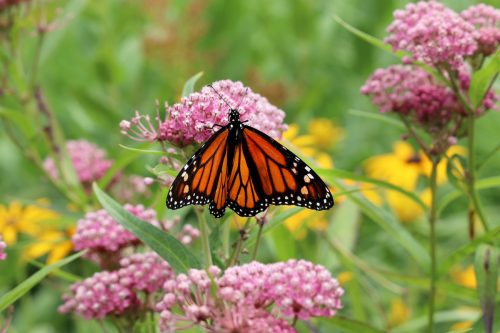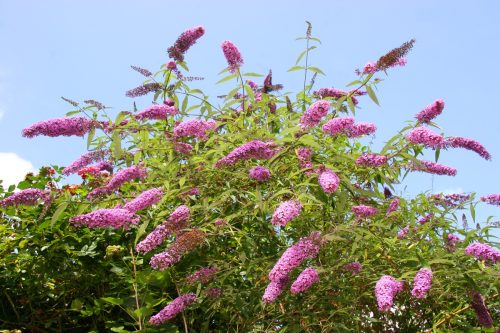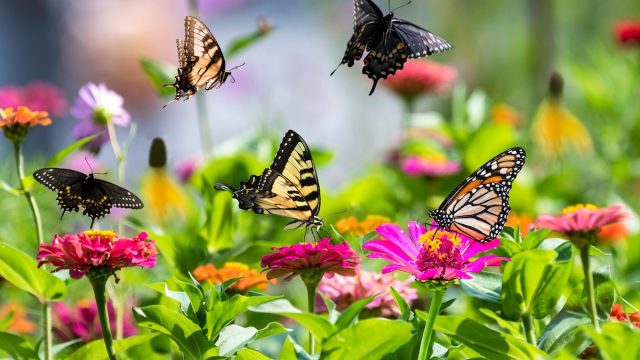6 Ways to Attract Butterflies to Your Backyard, According to Experts
These flowers and habitats will make your lawn a butterfly oasis.
Not only are butterflies beautiful to look at it, but they're also beneficial for your backyard. They help pollinate flowers, fruits, and vegetables in your garden, and they attract other important species like bees, birds, and ladybugs. Whether you're hoping to reap the environmental benefits of butterflies or you just find them pleasant and soothing to watch, there are some easy things you can do to increase their odds of landing on your lawn. Keep reading to hear from gardening experts about how to attract butterflies to your backyard.
READ THIS NEXT: This Is the One Weed You Should Never Pull, Experts Say.
How to Attract Butterflies
1. Add host plants.

The first thing you'll want to do is learn which butterflies are common where you live. From there, you can figure out which specific plant species make the best hosts, or the plants that butterflies will lay eggs on since they provide a food source for caterpillars.
"By planting host plants in your garden, you can encourage butterflies to lay their eggs and raise their young," says Ben Hilton, founder and editor at The Yard and Garden.
"For example, monarch butterflies lay their eggs on milkweed plants since the baby caterpillars feed on milkweed," explains Erinn Witz, a garden expert and co-founder of Seeds and Spades. "But only certain milkweed species are beneficial for monarchs, and some species can actually be harmful to them."
Other examples include parsley for black swallowtails and fennel for Eastern black swallowtails, notes Hilton.
2. Add native plants.

And since you're trying to attract native butterflies, you'll want to have native plants that they're accustomed to.
"Native plants provide a source of food and shelter for local butterflies, and they also help to support local ecosystems," says Hilton. "Select a range of flowers that bloom throughout the growing season in order to prolong the positive effect of this planting method."
He also recommends keeping part of your backyard wild since butterflies are attracted to natural habitats. "This can be an untamed section of your yard or a naturalized area with wildflowers and native grasses."
READ THIS NEXT: The 6 Best Herbs to Plant for Beginners, Experts Say.
3. Plant red, pink, purple, and white flowers.

"Butterflies do not see the same way humans do. They view the world on the ultraviolet light spectrum," explains Witz. "Because of this, butterflies see red, pink, and white most vividly, and they're attracted to these blooms."
Some nectar-rich flowers in these hues that Witz recommends are coreopsis, salvia, lantana, coneflowers, zinnias, and butterfly bushes.
4. Plant cabbage or kale.

In addition to host plants, you'll want to make sure your garden includes larval food sources.
"These are plants that caterpillars feed on as they grow," explains Hilton. "By providing these plants, you can ensure that there will be enough food for the caterpillars to grow and develop into butterflies."
He says caterpillars love plants in the Brassica family, like cabbage and kale.
For more gardening advice delivered straight to your inbox, sign up for our daily newsletter.
5. Provide water and sheltered habitats.

"Butterflies need shelter and protection from predators and harsh weather conditions," notes Hilton. He says you can create a butterfly-friendly habitat by making small sheltered areas composed of natural materials like plants and rocks.
And though butterflies get most of their water from nectar, puddles, or decaying fruit, as Witz notes, adding a small dish of fresh water or a birdbath will help attract them to your backyard.
6. Avoid pesticides.

Not surprisingly, pesticides are harmful to butterflies, as well as other beneficial insects like bees and ladybugs, says Hilton.
"If you must apply insect control, try natural pest control methods such as hand-picking pests, using insecticidal soaps, or introducing beneficial insects such as ladybugs and praying mantises," he suggests.






















